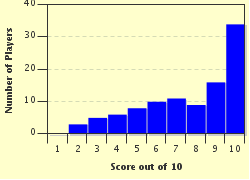Quiz Answer Key and Fun Facts
1. While they were once found all over the eastern states of Australia, the last known colony of Northern hairy-nosed wombats can now only be found in the Epping Forest National Park. In which Australian state can you find this park?
2. Which of these best describes the eating habits of the Northern hairy-nosed wombat?
3. Which of these best describes the preferred habitat of Northern hairy-nosed wombats?
4. What is so unique about wombat pouches compared to most other marsupials?
5. In the wild, what is the Northern hairy-nosed wombat's biggest predator?
6. The Northern hairy-nosed wombat is nocturnal.
7. Is there such thing as a Southern hairy-nosed wombat?
8. How many joeys do female Northern hairy-nosed wombats give birth to per litter?
9. Which of these statements regarding the Northern hairy-nosed wombat IS NOT true?
10. What is NOT one of the main reasons for the Northern hairy-nosed wombat's declining population?
Source: Author
Daaanieeel
This quiz was reviewed by FunTrivia editor
guitargoddess before going online.
Any errors found in FunTrivia content are routinely corrected through our feedback system.

